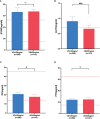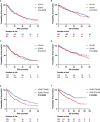Vitamin D deficiency linked to abnormal bone and lipid metabolism predicts high-risk multiple myeloma with poorer prognosis
- PMID: 37181039
- PMCID: PMC10173308
- DOI: 10.3389/fendo.2023.1157969
Vitamin D deficiency linked to abnormal bone and lipid metabolism predicts high-risk multiple myeloma with poorer prognosis
Abstract
Purpose: Vitamin D deficiency is frequent in patients with multiple myeloma (MM), however, its prognostic relevance in MM was rather inconclusive. We first investigated the association of vitamin D deficiency with abnormal bone and lipid metabolism in newly diagnosed multiple myeloma (NDMM), and next assessed the impact of serum ratio of vitamin D to carboxy-terminal telopeptide of type I collagen (β-CTX) on progression-free survival (PFS) and overall free survival (OS) in patients with NDMM.
Methods: The data of 431 consecutive patients with NDMM at Beijing Jishuitan Hospital from September 2013 to December 2022 were collected and retrospectively reviewed through our electronic medical record system. The measurement of 25-hydroxyvitamin D in the blood is an indicator of an individual's overall vitamin D status.
Results: The serum levels of vitamin D were negatively correlated with β-CTX in NDMM patients. Of note, positive correlation between vitamin D and cholesterol levels in the serum was found in this study. The cohort (n = 431) was divided into two groups based on the serum ratio of vitamin D to β-CTX. Compared to the group with a higher vitamin D to β-CTX ratio, the group with a lower vitamin D to β-CTX ratio (n = 257, 60%) exhibited hypocholesterolemia, inferior PFS and OS, along with increased cases of ISS stage-III and R-ISS stage-III, a higher number of plasma cells in the bone marrow, and elevated serum calcium levels. Consistent with this, multivariate analysis confirmed that the vitamin D to β-CTX ratio was an independent unfavorable indicator for survival in NDMM patients.
Conclusion: Our data demonstrated the ratio of vitamin D to β-CTX in the serum is a unique biomarker for NDMM patients to identify the high-risk cases with poor prognosis, which is superior to vitamin D itself for predicting PFS and OS in NDMM. Also, it is worth mentioning that our data on the connection between vitamin D deficiency and hypocholesterolemia might help clarify novel mechanistic aspects of myeloma development.
Keywords: cholesterol; newly diagnosed multiple myeloma; poor survival; ratio of vitamin D to β-CTX; vitamin D.
Copyright © 2023 Bao, Wang, Lu, Chu, Shi, Gao, Fang, Xiang, Ding, Liu, Zhao, Wang, Chen and Hu.
Conflict of interest statement
The authors declare that the research was conducted in the absence of any commercial or financial relationships that could be construed as a potential conflict of interest.
Figures




Similar articles
-
The Global Prevalence of Vitamin D Deficiency and Insufficiency in Patients with Multiple Myeloma: A Systematic Review and Meta-Analysis.Nutrients. 2023 Jul 20;15(14):3227. doi: 10.3390/nu15143227. Nutrients. 2023. PMID: 37513645 Free PMC article. Review.
-
Hypercalcemia caused by humoral effects and bone damage indicate poor outcomes in newly diagnosed multiple myeloma patients.Cancer Med. 2020 Dec;9(23):8962-8969. doi: 10.1002/cam4.3594. Epub 2020 Nov 4. Cancer Med. 2020. PMID: 33145966 Free PMC article.
-
Circular RNA_0003489 reflects unfavorable treatment response and shortened survival in newly diagnosed multiple myeloma patients who receive bortezomib-based induction therapy.Hematology. 2024 Dec;29(1):2399419. doi: 10.1080/16078454.2024.2399419. Epub 2024 Sep 13. Hematology. 2024. PMID: 39268977
-
[Clinical characteristics of bone disease in multiple myeloma and clinical significance of monitoring bone metabolic markers].Zhonghua Yi Xue Za Zhi. 2016 May 17;96(18):1424-9. doi: 10.3760/cma.j.issn.0376-2491.2016.18.008. Zhonghua Yi Xue Za Zhi. 2016. PMID: 27266350 Chinese.
-
Risk-benefit ratio of percutaneous kyphoplasty and percutaneous vertebroplasty in patients with newly diagnosed multiple myeloma with vertebral fracture: a single-center retrospective study.Ann Hematol. 2023 Jun;102(6):1513-1522. doi: 10.1007/s00277-023-05202-9. Epub 2023 Mar 30. Ann Hematol. 2023. PMID: 36997718 Free PMC article. Review.
Cited by
-
Lipid levels and multiple myeloma risk: insights from Meta-analysis and mendelian randomization.Lipids Health Dis. 2024 Sep 16;23(1):299. doi: 10.1186/s12944-024-02289-5. Lipids Health Dis. 2024. PMID: 39285309 Free PMC article.
-
The Global Prevalence of Vitamin D Deficiency and Insufficiency in Patients with Multiple Myeloma: A Systematic Review and Meta-Analysis.Nutrients. 2023 Jul 20;15(14):3227. doi: 10.3390/nu15143227. Nutrients. 2023. PMID: 37513645 Free PMC article. Review.
-
Lipid metabolic vulnerabilities of multiple myeloma.Clin Exp Med. 2023 Nov;23(7):3373-3390. doi: 10.1007/s10238-023-01174-2. Epub 2023 Aug 28. Clin Exp Med. 2023. PMID: 37639069 Free PMC article. Review.
References
-
- Cashman KD, van den Heuvel EG, Schoemaker RJ, Preveraud DP, Macdonald HM, Arcot J. 25-hydroxyvitamin d as a biomarker of vitamin d status and its modeling to inform strategies for prevention of vitamin d deficiency within the population. Adv Nutr (2017) 8(6):947–57. doi: 10.3945/an.117.015578 - DOI - PMC - PubMed
Publication types
MeSH terms
Substances
Grants and funding
LinkOut - more resources
Full Text Sources
Medical

